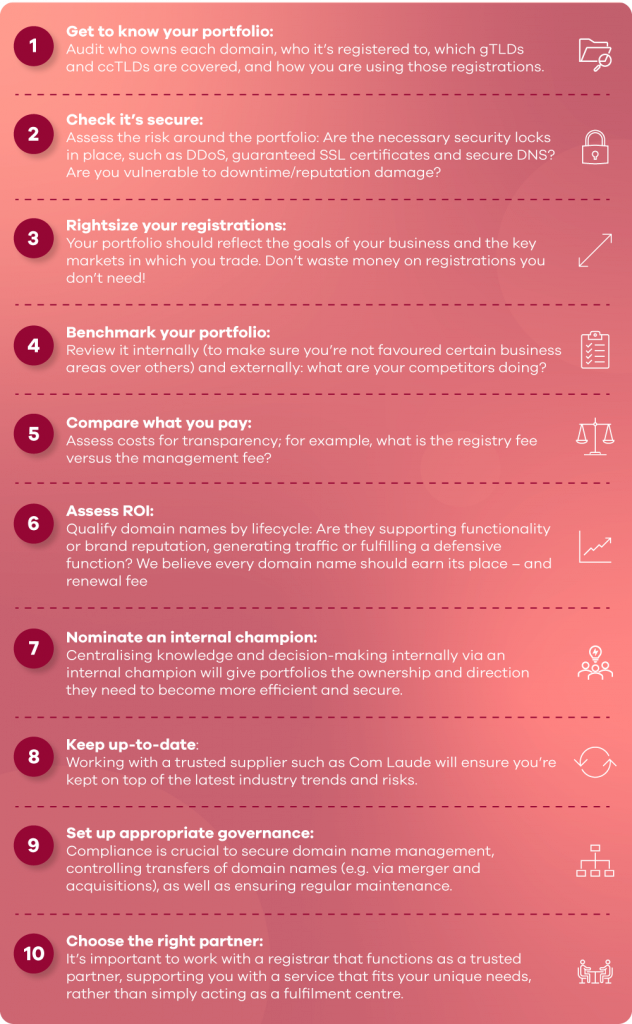Ask The Experts: Corporate Domain Name Management
Centralising domain name management and decision-making is key to success in challenging times, as Hayath Hussein, Group Client Services Director at Com Laude explains.
What are the biggest trends and challenges you’re seeing currently?
The COVID-19 pandemic has added fuel to existing trends in the domain name space, as companies that perhaps didn’t focus on their digital presence online before are now looking to play catch-up, in terms of registrations and presence, as well as the development of an effective domain name strategy.
Of course, it’s not only brand owners who are increasing their focus on online channels. The growth in web traffic has also led to an increase in criminal activity, such as phishing, hijacking, and domain name infringement. This places added pressure on companies to ensure proactive monitoring and enforcement, and to up their knowledge of and investment in security.
How and where should you start?
As most companies already know, registering corporate names in every possible domain, and every possible variation and spelling, is cost prohibitive. In our view, the best approach is to register what you need, and monitor what you don’t, based on brand strategy and market activity. Whether a registration is for traffic, brand awareness or for defensive reasons, we believe that every domain name should have a clear purpose and justify itself in terms of return on investment (ROI).
Assessing domain names from this perspective will enable companies to ‘rightsize’ their portfolios and inform future registration strategies, by focusing budgets on core brands and domains.
Typically, this should also include:
- securing brands in key registries, such as the dotcom, as well as in those jurisdictions which do not have a reliable dispute resolution mechanism (e.g. Russia and China);
- reviewing legacy registrations to measure for both allocation and ROI (it’s not unusual to find some product lines are more favoured in domain name registrations than others);
- assessing whether a brand or product name is at risk of manipulation; for example, homoglyphs and Cyrillic characters, and registering defensive domains accordingly; and
- monitoring non-critical domains for changes in activity, as well as registries for offers or discounts, which typically lead to an increase in infringing registrations.
However, each company is different, so it’s advisable to work with a supplier who will take the time to work with you to build a registration and enforcement strategy that will best support your business and its online needs.
How can you manage security threats?
The need to put in place the appropriate security measures – through a robust DNS, DDoS mitigation and registry locks – is important, but frequently overlooked. In particular, it’s essential that any domain that carries corporate infrastructure, such as email servers, are protected from both hacking and human error.
As hijackers and hackers have become more sophisticated, so must we. Security protocols are already built into the way we work at Com Laude, so that we will only make changes to such ‘mission critical’ sites for example, once the change has been authenticated by the appropriate named person and, only then, by following our strict processes, which are a part of our ISO 9001 and ISO 27001 certification.
However, not all brand owners have put in place the appropriate DNS, SSL, DDoS mitigation and registry locks that they need to ring-fence their important assets. As the number and extent of criminal attacks continues to increase, we advise companies to be as proactive as possible in this respect.
![]()
How should you structure domain name management?
The importance of centralising knowledge and decision-making around a domain name portfolio should not be underestimated. However, this can be tricky internally for companies given that domain names sit across many disciplines, such as digital marketing, IT and legal/IP.
It’s not unusual, for example, for the legal team to be asked to make decisions on renewals, but without knowing whether those registrations are actively still in use, or for IT teams to be unaware of upcoming brand launches. Clearly, it’s much easier to understand and control a portfolio, if a representative from all disciplines is involved in the decision-making process.
“The right hand must know what the left hand is doing when making domain name decisions.”
Working with a trusted partner can also pay major dividends here. We’ve supported most of our clients over many years, so we hold the knowledge about their portfolios that enables us to act as a gatekeeper. This helps to ensure consistency and to keep them up-to-date on registry activity and security threats, and also to act on their behalf to agreed parameters, thereby also taking the pressure off their teams.
For example, when domain name renewals become due, we can provide queries and traffic information to help inform the necessary decision-making. Our online portal also provides access to a complete overview of their domain name portfolio to allow for easy reviews. Data is powerful in this sense although, in our view, it is the knowledge held by our internal team and our personal approach to client management that makes the biggest difference.

To find out more about Com Laude’s Corporate Domain Name Management service, please contact us.
